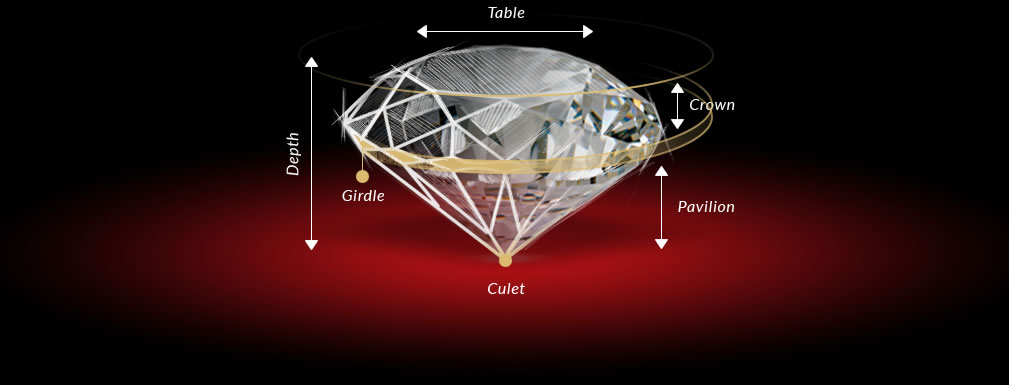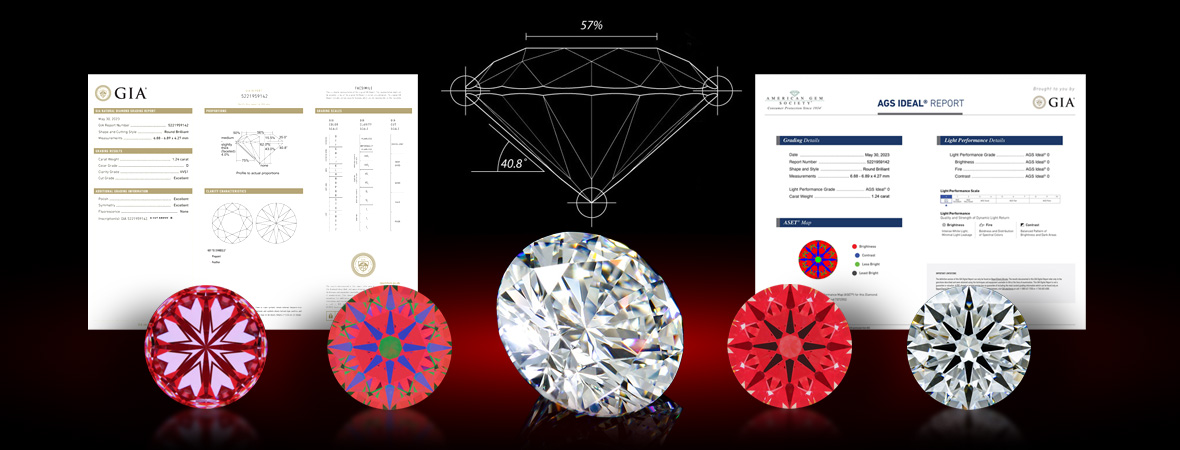
Even if all of a diamond's individual parameters are within the range for a particular cut grade, the wrong combination might actually cause the cut grade to be lower. As a result, the GIA looks at a diamond's proportions in relation to each other rather than considering the proportions individually.
To help you understand the terminology used to describe a diamond, we explore the anatomy of a diamond below.
Anatomy of a Diamond
The Table
The flat facet on the top of the diamond is called the table. It’s the largest facet on a cut diamond and serves as the primary window through which light enters from above , contributing significantly to the stone's light performance.
Table Percentage
Table percentage measures how the size of a diamond's table (flat top facet) compares to the diamond's overall diameter. The table is the main facet through which light enters the diamond from above, and its size and proportion relative to the entire diamond impact how light is reflected and refracted inside the stone.
- Round Diamonds: Calculated by dividing the table's length by the average girdle diameter.
- Fancy Shape Diamonds: Calculated by dividing the table's width (at its widest point) by the stone's overall width.
The ideal table percentage relative to other proportions ensures an optimal contribution to its overall light performance.
The Crown
A diamond's crown is the top portion located above its girdle.. The crown has several facets, including star facets, bezel facets, and upper girdle facets, which work together to influence light's entry and dispersion.
The crown angle and height are crucial to its performance. A shallow crown will result in a dull diamond with little fire. Alternatively, too steep a crown can allow light to escape rather than reflect back, reducing brilliance.
The Girdle
The girdle is the outer edge of the diamond, where the crown meets the pavilion, and forms a band around the stone. Both functionally and aesthetically it acts, primarily as a mounting point for the diamond. The girdle can also be faceted, polished, or left in a natural state - depending on the cut.
The diamond's durability and appearance are highly dependent on the thickness of the girdle. Having a girdle that is too thin can result in the diamond chipping, while an overly thick girdle can not only add hidden weight reducing its perceived size of the stone, but also negatively impact performance too.
The ideal girdle strikes a balance between these two extremes, ensuring both structural integrity and aesthetic appeal.
The Pavillion
Located below the girdle,
the pavilion is the bottom part of the diamond. The primary purpose of the facets on this portion of the diamond is to act as mirrors, internally reflecting light from the crown and table and directing it back toward the viewer.
Much like the girdle, you need to strike the balance just right. In diamonds with shallow pavilions light can escape rather than being returned to the eye, detracting from its brilliance and giving it a lifeless appearance. A deep pavilion will also allow light to escape resulting in a dark center.
A properly proportioned pavilion reflects and refracts light efficiently, creating the dazzling interplay of fire, brilliance, and scintillation that diamonds are celebrated for.
The Culet
The culet is located at the very bottom of a diamond’s pavilion. It may either be pointed or have a small facet on it that is parallel to the table facet. The purpose of a faceted culet is to prevent it from chipping. While older diamond cuts, such as the Old European or Old Mine cuts, often featured large, noticeable culets, modern diamonds typically have either no culet facet( pointed or a very small one.
In modern diamond cutting, a pointed culet is preferred, as it minimizes the interference with light performance. Large culets can be visible through the table of the diamond, appearing as a window in the bottom of the stone and detracting from the stone's overall brilliance and symmetry.
Jewelry settings today generally provide sufficient protection for the pavilion tip, rendering large culets unnecessary. For this reason, the presence of a large culet is now more commonly associated with vintage or antique diamond styles.
Depth
Depth refers to the height of a diamond from the culet to the table, measured in millimeters. Diamond proportions and light performance are influenced by this dimension. This depth plays a direct role in how light is refracted and reflected within the stone, contributing to its brilliance and fire.
The optimal depth percentage relative to its diameter is found within a range carefully calculated to complement the diamond's table size, crown angle, and pavilion angle. Diamond performance and aesthetics are greatly enhanced
when depth is complementary with other key measurements, such as table and crown proportions.
Crown Angle
A crown angle refers to the angle formed between the crown facets (the upper half of a diamond above the girdle) and the plane of the girdle. Diamond brilliance and fire are heavily influenced by this angle, which determines how light reflects through the diamond.
The ideal crown angle depends on the shape of the diamond, and for rounds is between 34 and 35 degrees. An ideal crown ensures light entering through the table is effectively reflected and dispersed, creating a vibrant sparkle.
If the crown angle is too shallow, the crown height will be too low to gather light efficiently.. If it’s too steep, it will not complement pavilion angles in the optimal range resulting in light performance deficits.
The crown angle, in relation to the table and pavilion angle, play a key role in a diamond's light performance and visual appeal.
Facet

Facets are the polished flat surfaces on a diamond that allow light to enter, reflect, and refract, and return to the eye in the form of white and colored sparkles.. In order to create the most stunning display of light, every facet in the diamond must be cut and aligned meticulously to in 3 dimensional space.
Historically the most popular shape,
round brilliant cut diamonds, typically have 58 facets (57 without the culet). There are 33 facets on the pavilion (bottom) and 25 on the crown (top).
Other popular diamond cuts,
such as the emerald cut, also feature 57 separate facets - with the largest being the table facet. With cropped corners, it forms the shape of an octagon.
Each facet’s angle, placement, and symmetry are essential in how light behaves within the diamond and in the quality of light that is returned to the eye. Properly cut facets are crucial to the
diamond’s scintillation, brilliance, and fire.
Diamonds with well-aligned facets reflect light beautifully at every angle, giving them their
signature sparkle. Skill and craftsmanship are required for revealing the full potential of a diamond. It’s through the process of faceting and polishing a diamond that a diamond's fire and brilliance are unleashed.
In any lighting situation, an A CUT ABOVE® diamond will be the star of the show, displaying its full beauty from every angle. The light will flash and sparkle with every glance, creating a mesmerizing light show. For a full understanding of these elite diamonds, please see our
specifications and qualifications page.
Symmetry
As reported on diamond certificates,
symmetry refers to the proper alignment of contiguous facets. Facets should meet one another at consistent points around the diamond. This is also known as “meet point” symmetry.. Symmetry is a reflection of the level of craftsmanship and also plays a critical role in its light performance and visual appeal, as misalignments can negatively impact the diamond. Symmetry quality is rated on a scale: Ideal (AGS), Excellent, Very Good, Good, Fair, and Poor.
Another type of symmetry that is not specifically graded on laboratory reports is 3D symmetry, also referred to as Optical Symmetry or Optical Precision. This is a measure of how well aligned corresponding facets are in 3D space. This symmetry is critical to fully optimize the diamond’s light handling capabilities. A perfect pattern of
Hearts and Arrows is only possible when the diamond has proportions in the ideal range and elite facet precision and optical symmetry.
Diamonds with ideal symmetry will have perfectly aligned facets to ensure optimal light reflection and uniform, symmetrical appearance from all angles. A well-cut diamond should possess superior symmetry to provide the greatest brilliance, fire, and scintillation.
Fluorescence
Some
diamonds emit fluorescence under UV light, which is a natural phenomenon that occurs when certain trace elements are present in the stone. Most commonly diamonds fluoresce blue with strengths ranging from none to very strong.
It is possible for diamonds with strong fluorescence to lose some transparency and appear milky or hazy in lighting environments containing UV radiation of sufficient intensity, such as direct sunlight. This can result in a reduction of their brilliance and sparkle! Blue fluorescence is also known to have a whitening effect on diamonds by cancelling some yellow body color in lighting conditions with intense UV.
But most people won't see any impact of fluorescence under normal lighting conditions. Fluorescence is only triggered in a very limited number of lighting environments and therefore has very limited impacts on visual appearance. GIA has concluded that fluorescence by itself does not normally cause loss of transparency. It is usually in conjunction with light scattering inclusion types such as twinning wisps and graining that milkiness is seen in strongly fluorescent diamonds.
How does the Anatomy of a Diamond Affect its Sparkle?
In order to maximize the efficiency of light interaction with a diamond, each part of its anatomy plays an integral role. Most notably:
- The table, the largest facet on the top, allows light to enter and reflect within the diamond.
- The crown, which is the upper portion above the girdle, angles the light to create dispersion and brilliance.
- The pavilion, located below the girdle, is critical for reflecting light back through the table and crown to maximize sparkle.
In order to create fire, brilliance, and
scintillation, the cut quality of a diamond is the most important factor, which includes the symmetry and proportions of the facets. Poorly cut diamonds will leak light, reducing their sparkle and brilliance.
Diamond cut is the number one factor determining a diamond’s beauty.
Diamonds that Sparkle from Whiteflash
Buying with confidence goes beyond simply getting a good deal on a quality product. A leader in the diamond jewelry industry with special expertise in light performance, Whiteflash is committed to finding the perfect diamond for you. We strive to ensure that your diamond buying experience is seamless and enjoyable by providing exceptional service and guidance.
Whiteflash specializes in offering exquisite diamonds, engagement rings, fine jewelry, and providing unparalleled customer care. Find your perfect diamond by visiting our showroom or browsing our online collection. Let us help you discover the diamond of your dreams.
Please contact us with any questions you may have about diamonds and we will be glad to help you find the perfect diamond that symbolizes your eternal bond and captures hearts for generations to come.